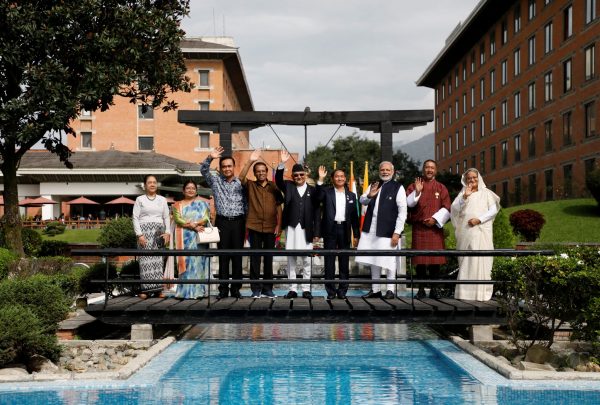The exercise came just a fortnight after the 4th BIMSTEC summit was held in Kathmandu. The summit saw the signing of a memorandum of understanding on establishing a grid interconnection to enhance energy cooperation among the seven BIMSTEC member states — Bangladesh, Bhutan, India, Myanmar, Nepal, Sri Lanka and Thailand.
Adding to the momentum, the group also gathered in Thailand soon after the military exercise to discuss the BIMSTEC Transport Connectivity Master Plan, which will be finalised in 2018 and is set to be a US$50 billion project.
This flurry of activity is unusual for the sub-regional grouping, which has had very little visibility even within the region in the last two decades. Established in 1997, BIMSTEC planned to hold summits every two years, ministerial meetings every year and senior officials’ meetings twice a year. But the last two decades only saw three summits, and from 2014–17 no ministerial meetings were held and the senior officials’ meeting was postponed seven times.
Changing geopolitical realities in the region have brought about renewed interest in the Bay of Bengal. As the regional grouping of choice in South Asia — SAARC, or the South Asian Association for Regional Cooperation — flounders with strained India–Pakistan relations, New Delhi has realised that BIMSTEC would allow for a broader playing field.
Strategically located in the Indian Ocean, the Bay of Bengal and BIMSTEC not only caters to the wider concept of the ‘Indo-Pacific’ and an Indian Ocean community that New Delhi espouses, it also includes two ASEAN member states (Myanmar and Thailand) in its ranks, which is crucial for New Delhi’s key foreign policy priorities — its Act East and ‘neighbourhood first’ policies.
Both these policies aim for connectivity and development in the frontier states of India’s northeast and tackle the issue of cross-border insurgency that has plagued the region for decades. With India’s northeast sharing borders with four BIMSTEC countries, including Myanmar, the possibility of multi-regional cooperation with Southeast Asia and ASEAN makes it an attractive alternative to the SAARC.
Another major catalyst for the renewed interest in BIMSTEC is China. The Bay of Bengal is a crucial access route to the Indian Ocean for Beijing. As such, China has launched multiple infrastructure development projects across South and Southeast Asia through its Belt and Road Initiative (BRI).
For some BIMSTEC members like Sri Lanka, successfully engaging in the sub-regional grouping proves its ability to play a larger role in the BRI. For others, such as Myanmar and Thailand, BIMSTEC allows for a way to redress over-dependence on China and balance Beijing by providing access to consumer markets in India and other rising BIMSTEC economies.
BIMSTEC failed to generate interest and visibility even within the region in the last 20 years. Now that the sub-regional grouping has finally managed to gain momentum, it is crucial for BIMSTEC to maintain it and show tangible results on the ground.
To do this, BIMSTEC should first narrow down its areas of focus from 14 to six — trade and investment, connectivity, energy, people-to-people exchanges, counter-terrorism and the blue economy — and enhance the institutional capacity of its secretariat.
The BIMSTEC region also requires a free trade agreement (FTA), no matter how limited in scope. Even with a combined GDP of US$2.8 trillion, intra-regional trade in BIMSTEC barely exceeds 5 per cent, compared to ASEAN’s 30 per cent. Negotiations for a BIMSTEC FTA have been dragging on for the last 14 years.
To facilitate a FTA, connectivity should be prioritised. The Bay of Bengal is one of the least integrated regions in the world despite being home to 1.6 billion people, or nearly 23 per cent of the world’s population. A Thailand-initiated scheme to ‘Connect the Connectivities’ under the pending BIMSTEC Coastal Shipping Agreement aims to link BIMSTEC members through a network of ports running from Thailand, Bangladesh, India’s Kolkata, Chennai and Visakhapatnam, and Sri Lanka.
Putting aside the fact that BIMSTEC has several connectivity projects in the pipeline, slow movement on the ground is a reason why the sub-regional grouping has been largely rendered ineffective until now.
BIMSTEC should prioritise finishing up the India–Myanmar–Thailand Trilateral Highway and the Kaladan Multi-modal Transit Transport Project, which will enable sea access for India’s landlocked northeastern states via the Kaladan river in Myanmar. Both projects have lagged behind deadlines for years.
With access to the Indian Ocean and the Himalayas, BIMSTEC is becoming the theatre of convergence and competition for China’s BRI, India’s Act East policy, and Japan and India’s Asia–Africa Growth Corridor. It remains to be seen if BIMSTEC can seize the day and utilise the momentum to remodel itself as a grouping to be reckoned with.
Nazia Hussain is a Research Analyst at the S Rajaratnam School of International Studies (RSIS), Nanyang Technological University, Singapore.
An earlier version of this article appeared here on RSIS.

